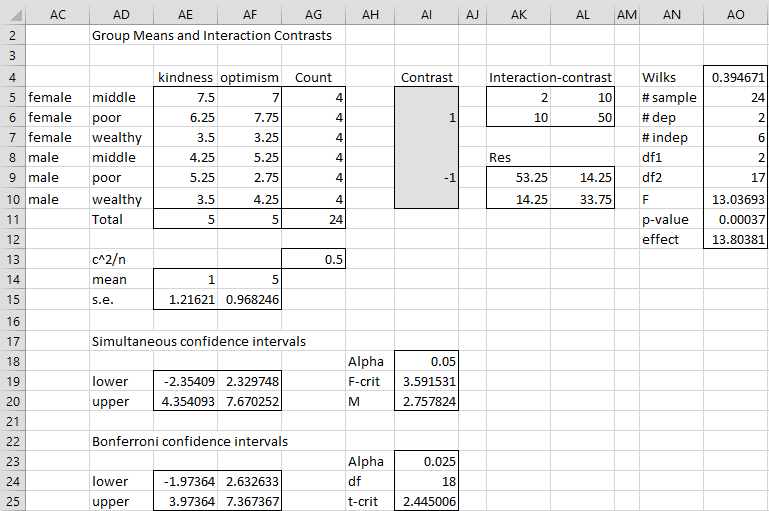Basic Concepts
If the test of the interaction of the factors for a Two-way MANOVA is significant, then contrasts can be used as a post-hoc test. These tests are similar to those for one-way MANOVA. The only difference is that pairs of independent variable values are presented. Once the contrast coefficients are specified, a Wilks test is performed and both simultaneous confidence intervals and Bonferroni confidence intervals are calculated.
As usual, a Bonferroni correction should be used for the Bonferroni version based on the number of tests that are planned (prior to the collection of data or conducting tests).
Contrasts
For Example 1 of Two-way MANOVA Example, we can select the Contrasts option on the dialog box shown in Figure 2 of Two-way MANOVA Example. At first, the contrast coefficient range (AI5:AI10 in Figure 1) will be blank. You need to fill in the values based on the test that you plan to conduct, making sure that the sum of the coefficients is zero. E.g. to test poor males versus poor females, place +1 and -1 in the shaded range as shown in Figure 1. The values of the other cells will change, resulting in the output shown in Figure 1.
Figure 6 – Contrasts for interaction factor of two-way MANOVA
We see that p-value = .00037 (cell AO11) and so we conclude that there is a significant difference in kindness and optimism between poor men and poor women. Based on the confidence intervals shown in AE19:AF20 and AE24:AF25, we see that this difference is based on optimism and not kindness; e.g. for two distinct Bonferroni tests (and so alpha = .05/2 = .025), the 95% confidence interval for optimism is (2.63, 7.37), while that for kindness is (-1.97, 3.97).
Examples Workbook
Click here to download the Excel workbook with the examples described on this webpage.
References
Lin, C-D J. (2010) Planned contrasts and post hoc tests in MANOVA made easy
https://www.lexjansen.com/wuss/2010/analy/2981_3_ANL-LIN.pdf
Ender, P. (2007) Multivariate Statistical Analysis
This document is no longer available on the Internet
Tsay, R.S. (2016) Applied Multivariate Analysis. Lecture Notes
https://faculty.chicagobooth.edu/ruey-s-tsay/research/multivariate-time-series-analysis-with-r-and-financial-applications
Penn State (2023) Two-way MANOVA additive model and assumptions
https://online.stat.psu.edu/stat505/lesson/8/8.10
